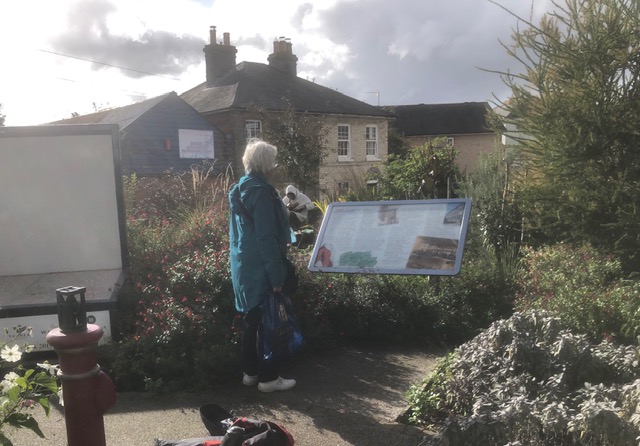The Bower & Collier Family History
Research by Colin Bower
Silk Weavers named Collier
Visit to Weavers' Piece in Sudbury October 2024
The garden at Weavers' Piece is a short walk from the Information Centre, from which I was given a leaflet, 'A celebration of silk weaving. Weavers' Piece introduced by Talbot' (a dog).
The garden has:
- a sculpture of Talbot the dog (the Sudbury Town crest includes a black dog that is a Talbot, which were hunting dogs in the middle ages)
- one of a series of red posts around the town (the one in Weavers' Piece has a Jacquard loom on top). Talbot the dog is in the background!
- two information boards
First Information Board

A photo of the first information board shows a former silk manufactory, now the Dental Emporium, in the background.
The text of the board reads:
Sudbury - The Arrival of Silk manufactoring
Silk making began in China but by the late Middle Ages the same skills were being used in France and Italy.
The weaving of silk became a mark of a person's position in society and silk products commanded high prices.
In 1609 King James made an unsuccessful attempt to stimulate silk making in England but later religious disputes at the end of the 17th century were to have more impact.
There was a mass exodus of protestant Huguenots from France in 1685 when the Catholic King, Louis XIV, revoked the Edict of Nantes.
They brought to England their weaver arts and skills, including silk weaving. Many came to Spitalfields in London.
By the mid 18th centiry the industry in Spitalfields was well established but plagued by frequent industrial disputes between masters and men, particlalry over wages.
In 1774, magistrates in Spitalfields decided to regulate wages in the local silk industry. As a result, many masters then began to move production from London to nearby country areas.
Silk weaving arrived in towns such as Haverhill, Glemsford and Sudbury. There were many skilled textile workers who were happy to work for wages that were higher than they could obtain in weaving traditional fabrics but still only two thirds of what silk masters would have had to pay in Spitalfields.
Records show that by 1844 there were four silk manuafcurers and some 600 silk looms in Sudbury. At this stage, silk weaving was still a hand process and was largely carried out by weavers working from home. Three storey terraced houses were built to house the weavers and their families.
The middle floor was occupied by the weaver's loom and had large windows to admit maximum light. Long terraces of these weavers' cottages are still a distinctive feature of Sudbury's townscape. Examples can be seen in Melford Road, New Street, East Street, Station Road, Cross Street and Ballingdon Street.
In 1860 the employers had begun to establish more efficient manufactories. here large numbers of weavers worked under one roof in rooms that could accommodate the wider hand looms in the taller Jacquard looms for weaving intricate velvets and damasks.
One of these manufactories still survives, 'The Dental Emporium' that you can see across the street. The picture below shows how the ground floor machinery was being used in.. (could not read the year quoted).
Second Information Board
The second information board draws the reader's attention to 3 silk firms that continue the proud and long tradition of textile manufacture in the town.
I was able to list the information on 2 of the firms, of which I had previously heard from my research into the silk industry in London.
Stephen Walters and Sons Ltd
The business started at Spitalfields in 1750 and moved to Sudbury in the mid 19th century.
The company has been run by the same Walters family for nine generations and is regarded as the oldest manufacturer in the country.
Stephen Walters now produce a wide range of fashion fabrics and designs at their factory in Cornard Road.
They made the silk for the lining of the Queen's Coronation Robe and for the wedding dresses of both the Princess Royal and Princess Diana.
Vanners Silk (Silk Industries Ltd)
Vanners, which also originated in Spitafields, made a late move into Suffolk in the 1870s, when they opened warehouses in Glemsford (1871) and Haverhill (1874).
A merger with Fennel Brothers brought Vanners into Sudbury and their production is now concentrated in their premises in Gregory Street.
Much of their output is channelled to the American tie market. Designs are produced in computerised looms which have dramatically increased productivity while assuring the highest quality.
Gainsborough Silk Weaving Company
I did not photo the details of the third comapny but understand that the company was started by Mr Reginald Warner in 1903.
Colin Bower
31 January 2025
